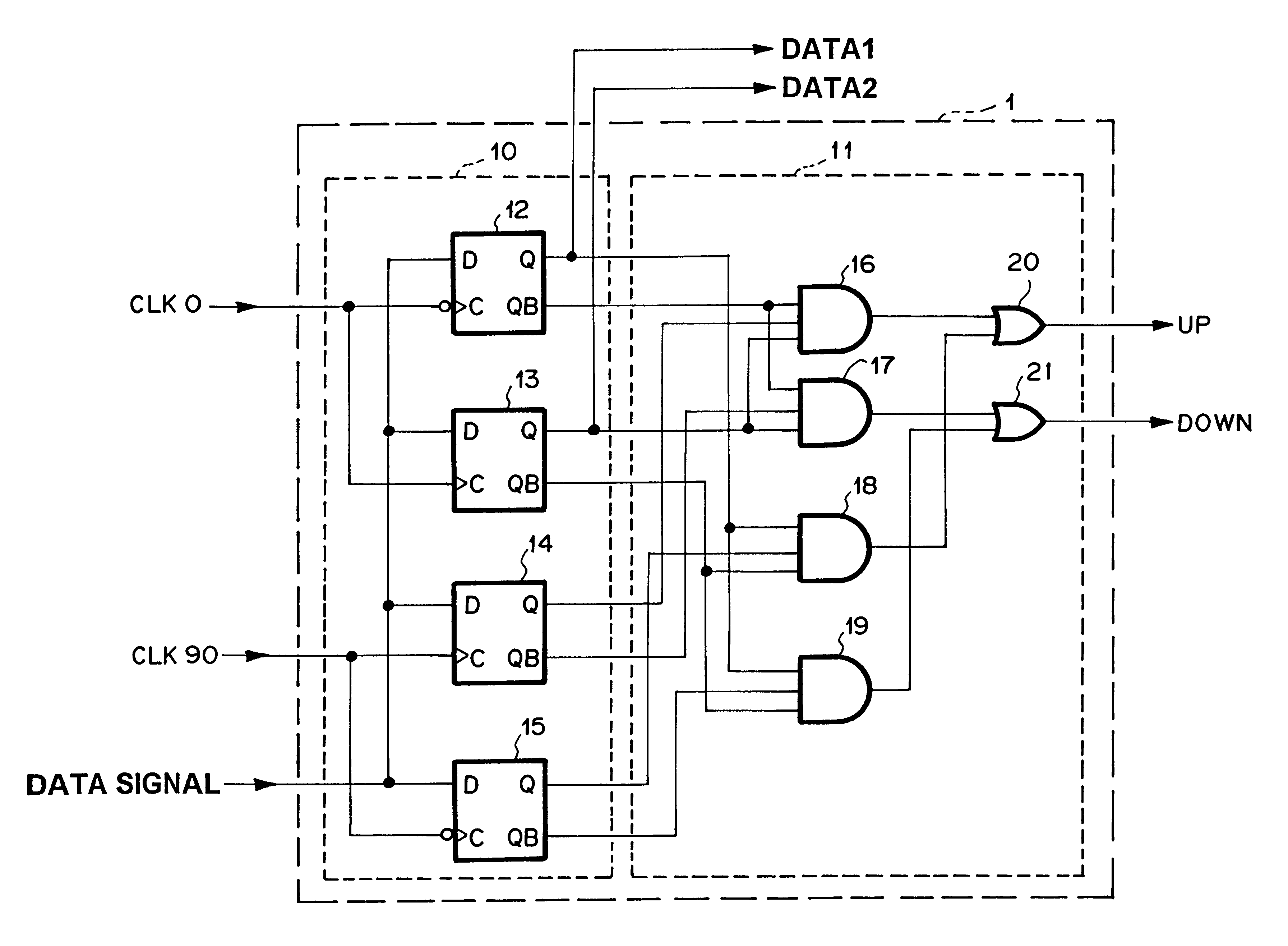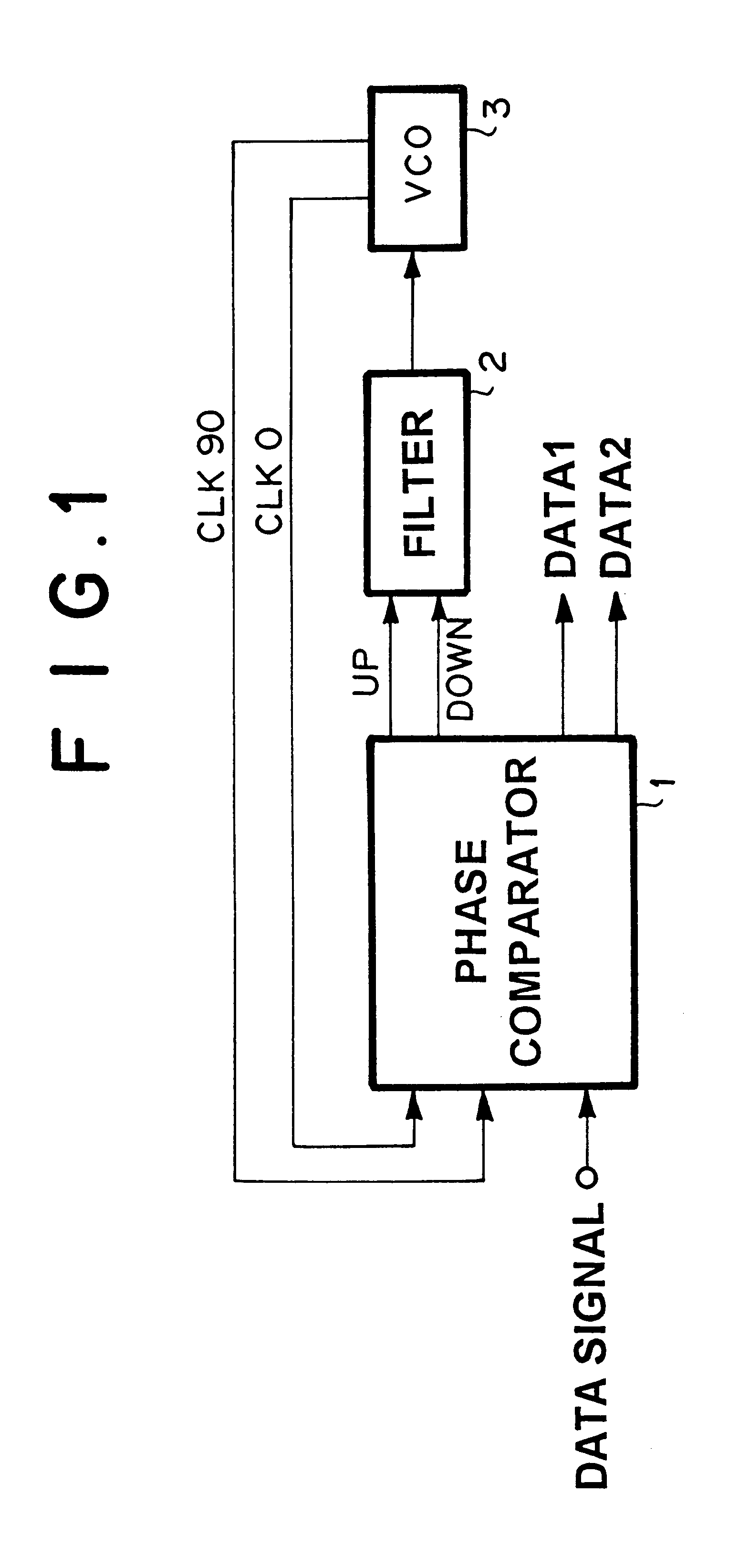Two phase digital phase locked loop circuit
a digital phase and loop circuit technology, applied in digital transmission, pulse automatic control, instruments, etc., can solve the problems of low power consumption of cmos, low speed of cmos in general, and high electric power consumption of si bipolar transistors
- Summary
- Abstract
- Description
- Claims
- Application Information
AI Technical Summary
Problems solved by technology
Method used
Image
Examples
first embodiment
The first embodiment is shown in FIG. 1.
The inputs into phase comparator 1 are NRZ data signal, clock signal CLK0 of which frequency is a half of that of the NRZ data signal, and CLK90 of which phase is shifted by .pi. / 2, compared with CLK0. Here, CLK0 and CLK90 are outputted from VCO 3.
Phase comparator 1 outputs UP signal, when the clocks are delayed, compared with the NRZ data signal, while it outputs DOWN signal, when the clocks are advanced, compared with the NRZ data signal.
Filter 2 outputs a control voltage for raising the frequency of VCO 3 on the basis of the UP signal, while it outputs a control voltage for lowering the frequency of VCO 3.
VCO 3 outputs CLK0 and CLK90 on the basis of the output from filter 2.
Phase comparator 1 as shown in FIG. 2 comprises sampling circuit 10, up down signal output circuit 11. Here, sampling circuit 10 comprises first determination means 12, second determination means 13, first DFF 14, and second DFF 15.
Further, in the first embodiment, first...
second embodiment
is shown in FIG. 4.
Phase comparator 1 comprises sampling circuit 10 and up-down signal output circuit 11, similarly to that as shown in FIG. 2. Further, sampling circuit 10 comprises first and second determination means 12 and 13, respectively, first and second DFFs 14 and 15, respectively. Up down signal output circuit 11 comprises first to fourth AND circuits 16 to 19, respectively, first and second OR circuits 20 and 21, respectively. The operations of sampling circuit 10 and up down signal circuit 11 are the same as those of sampling circuit 10 and up down signal circuit 11 as shown in FIG. 2.
The data input terminal D of third DFF 30 is connected with the output terminal of first OR circuit 20. The data input terminal D of fourth DFF 31 is connected with the output terminal of second OR circuit 21. CLK90 is inputted into the clock input terminal D of third and fourth DFFs 30 and 31, respectively. The UP signal is outputted from the output terminal Q of third DFF 30, while the DO...
third embodiment
is shown in FIG. 6.
First or second determination means 12 or 13, respectively, in sampling circuit 10 in phase comparator 1 in the third embodiment is shown in FIG. 6. First or second determination means 12 or 13, respectively, comprises first to third latches 40 to 42, respectively.
First to third latch circuits 40 to 42, respectively, latch data DD at the rise up of clock CC, hold the DD during the rise up and fall down of clock CC, and output inverted DD from the terminal O. First or second determination means 12 or 13, respectively, outputs a positive logic output Q from output terminal O of second latch 32, and also outputs an inverted logic output QB from output terminal O of third latch 33.
Determination means 12 latches the data signal at the fall down of the clock, while determination means 13 latches the data signal at the rise up of the clock. Therefore, the output Q from first determination means 12 and the output QB from second determination means 13 are outputted simulta...
PUM
 Login to View More
Login to View More Abstract
Description
Claims
Application Information
 Login to View More
Login to View More - R&D
- Intellectual Property
- Life Sciences
- Materials
- Tech Scout
- Unparalleled Data Quality
- Higher Quality Content
- 60% Fewer Hallucinations
Browse by: Latest US Patents, China's latest patents, Technical Efficacy Thesaurus, Application Domain, Technology Topic, Popular Technical Reports.
© 2025 PatSnap. All rights reserved.Legal|Privacy policy|Modern Slavery Act Transparency Statement|Sitemap|About US| Contact US: help@patsnap.com



